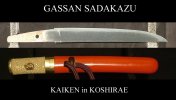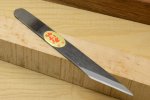Kwaiken/Kiridashi is generally a small utility knife for sharpening pencils and cutting string, etc. 1.5" to 2" blade, 3" to 4" handle, 1/2 to 3/4 wide. They can be wrapped handles or wood. They always include a saya.
The kiridashi ( or kiridashi) is a small angular tip craft knife. It is the equivalent of the X-acto knife of today. It was used to sharpen and shape pen quills, trim paper, and cut string. Scribes used it to shape brush tips and carve wood blocks for printing signatures. Carpenters used a slightly larger version for marking wood and trimming mortise/tenon joints. In Japan, all children carried one to school in their "pencil box" ( anyone remember those

). It was part of any scholar's writing desk set. Our small Western "pen knife" ( penknife) had the same use and history.
Pen knives and kiridashi are thousands of years old. For most of their history, they resembled a scalpel or X-acto knife ( pen knives did not fold until very recently). Because metal (especially steel) was scarce, the small thin blade was usually bound on the end of a split dowel with waxed cord.
A Kwaiken ( or kaiken) is a "pocket knife" or "sleeve knife" originally carried by women. The name means "Bosom knife". It later became part of the Samurai equipment, but specifically was carried by women. All wives of a Samurai class man were expected to carry one. It was a small knife carried in the inside pocket of a kimono sleeve or inside the lapel. It was used for grooming tasks, cutting loose threads or string, and in an emergency, self defense. It is the equivalent of the Scottish Sgian Dubh. One additional use came from the Samurai tradition ... it was used by women for ritual suicide. The neck veins and arteries were quickly cut through with it. If their husband was incapacitated by his wounds, they would cut his neck veins, then their own.
This tread has some shots of a two of my kiridashi and kwaiken:
https://www.bladeforums.com/threads/been-getting-some-shop-time-in-lately-pictures-added.1106842/
I have close-up shots somewhere, but can't find them right now.


